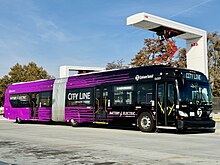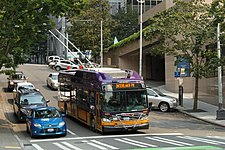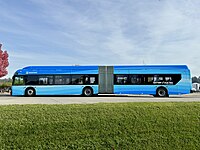The MTA Regional Bus Operations bus fleet is a fleet of buses in fixed-route service in New York City under the "MTA New York City Bus" and "MTA Bus" brands, both of which operate local, limited, express and Select Bus Service routes.

Omnitrans, stylized as "OmniTrans," is a public transportation agency in San Bernardino County, California, United States. The largest transit operator within San Bernardino County, it serves the San Bernardino Valley. The agency was established in 1976 through a joint powers agreement and today includes 15 cities and portions of the unincorporated areas of San Bernardino County. In addition to the southwestern corner of San Bernardino County, Omnitrans provides service to parts of Riverside and Los Angeles Counties. Omnitrans currently carries about 11 million passengers per year. Omnitrans currently operates fixed route bus service, bus rapid transit and a paratransit service for the disabled, “Access.” Omnitrans operates throughout the urbanized area of southwestern San Bernardino County: south of the San Bernardino Mountains, from Upland, Montclair, and Chino in the west to Redlands, California and Yucaipa in the east. The Omnitrans service area covers approximately 480 square miles (1,200 km2).

A battery electric bus is an electric bus that is driven by an electric motor and obtains energy from on-board batteries. Many trolleybuses use batteries as an auxiliary or emergency power source.

The Orion VII is a line of low-floor transit buses available in 30' rigid, 35' rigid, and 40' rigid lengths manufactured by Daimler Buses North America's subsidiary Orion Bus Industries between 2001 and 2013 in three generations. The conventional powered buses, either with longitudinally-mounted diesel or natural gas engines, used a T-drive transmission coupling. A series hybrid variant powered by a diesel-driven generator was also available. The Orion VII replaced the fully low-floor Orion VI and high-floor Orion V buses, and was manufactured until its parent company DaimlerChrysler withdrew from the transit bus market in 2013.
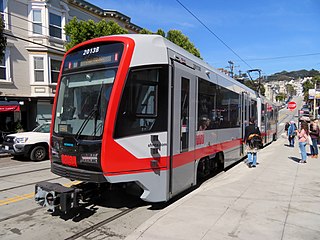
With five different modes of transport, the San Francisco Municipal Railway runs one of the most diverse fleets of vehicles in the United States. Roughly 550 diesel-electric hybrid buses, 300 electric trolleybuses, 250 modern light rail vehicles, 50 historic streetcars and 40 cable cars see active duty.
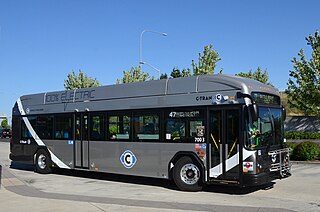
The Gillig Low Floor is a transit bus manufactured by Gillig since 1997. The second low-floor bus design introduced in the United States, the Low Floor originally served as a second product range for the company alongside the Gillig Phantom. As transit bus operators shifted toward low-floor designs, the Low Floor has replaced the Phantom entirely, becoming the sole vehicle platform offered by the company since 2008.

The Seattle trolleybus system forms part of the public transportation network in the city of Seattle, Washington, operated by King County Metro. Originally opened on April 28, 1940, the network consists of 15 routes, with 174 trolleybuses operating on 68 miles (109 km) of two-way parallel overhead lines. As of the fourth quarter of 2023, the system carries riders on an average of 39,900 trips per weekday, comprising about 18 percent of King County Metro's total daily ridership. At present in Seattle, a very common alternative term for trolleybus is trolley.

The Allison Bus Series are medium and heavy duty automatic transmissions for transit buses and highway motorcoaches designed and manufactured by Allison Transmission. Each of the six models in the Bus Series is available in 5 or 6 speeds with an integral hydraulic retarder as an option.

The BYD K-series bus are a line of battery electric buses manufactured by the Chinese automaker BYD, powered with its self-developed lithium iron phosphate battery, featuring a typical operating range of 250 kilometres (160 mi) per charge under urban road conditions. It is available in several different nominal lengths, from 7.0 to 13.7 m and also as a 18 m (60 ft) (articulated) bus. The rear axle is powered by two electric traction motors; the battery capacity and motor power of each model varies depending on the nominal length and passenger capacity.
As of 2017, King County Metro operates the 10th largest fleet of buses in the United States, with a total of 1,540 buses.

Albuquerque Rapid Transit, also known as ART, is a bus rapid transit (BRT) system serving the Central Avenue corridor in Albuquerque, New Mexico, United States. There are two lines running between Tramway Boulevard, the Central and Unser Transit Center (CUTC), and the Uptown Transit Center (UTC). It was built in 2016–17 and began limited operation in November 2017, but was subsequently delayed for over two years due to problems with the stations and buses. After the original fleet of electric buses was replaced with diesel buses, the line began regular service on November 30, 2019.

The New Flyer Low Floor is a line of low-floor transit buses that was manufactured by New Flyer Industries between 1991 and 2014. It was available in 30-foot rigid, 35-foot rigid, 40-foot rigid, and 60-foot articulated lengths. In addition to the different available lengths, the buses were sold with a variety of prime movers, ranging from conventional diesel and CNG combustion engines to diesel-electric hybrid, gasoline hybrid, and hydrogen fuel cell.

The New Flyer Invero (D40i) is a line of low-floor transit buses that was manufactured by New Flyer Industries between 1999 and 2007. Produced as a 40-foot (nominal) rigid bus, the Invero was typically sold with a conventional diesel combustion engine, although a few diesel-electric hybrids were built, integrated by Stewart & Stevenson. New Flyer introduced the Invero in 1999 with the intent that it would replace the preceding New Flyer Low Floor line, but few Inveros were sold, and the line was discontinued in 2007; in 2008, New Flyer introduced the Xcelsior, replacing both the Low Floor and the Invero lines.

The New Flyer High Floor was a line of conventional (high-floor) transit buses available in 35' rigid, 40' rigid, and 60' articulated lengths manufactured by New Flyer Industries between 1987 and 1996. The buses were powered by conventional diesel or natural gas engines using either V-drive or T-drive transmission couplings, with the exception of an articulated electric trolleybus variant manufactured for a single customer, the San Francisco Municipal Railway. The New Flyer Low Floor, a low-floor bus with a similar external appearance, was introduced in 1991 and proved to be more popular than the High Floor, which was discontinued in 1996 in diesel rigid form. CNG high-floor buses continued to be made until 1999, and the articulated version was manufactured until early 2006.

The Proterra Catalyst is a battery-electric low-floor transit bus that was built by Proterra from 2014 to 2020. The second generation of Proterra's battery-electric buses, it succeeded the earlier EcoRide as the company's flagship product.

The NABI BRT is a line of low-floor transit buses available in 60' articulated (60-BRT) and later 42' rigid (42-BRT) nominal lengths manufactured by North American Bus Industries (NABI) between 2004 and 2015. In addition to the different available lengths, the buses were sold with a variety of prime movers, ranging from conventional diesel and CNG combustion engines to diesel-electric hybrid.
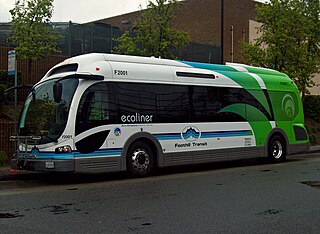
The Proterra EcoRide BE35 is a 35 foot (11 m) fast-charge battery electric bus that seats 38 with a total passenger capacity of 60 in its composite low floor body. Foothill Transit was the first transit agency to operate the buses in revenue service, starting in September 2010. It is the first 30 ft (9 m) or larger, heavy-duty all-electric bus ever to complete federally required durability, reliability and safety testing at the Bus Research and Testing Center in Altoona, Pennsylvania. The 12yr/500,000 mi (800,000 km) STURAA test was completed on March 5, 2012.

The ENC Axess is a line of low-floor transit buses available in 35-foot and 40-foot nominal lengths manufactured by ENC in Riverside, California starting from 2003. In addition to the different available lengths, the buses are sold with a variety of prime movers, ranging from conventional diesel, LNG/CNG combustion engines, diesel-electric hybrid and hydrogen fuel cell with a traction motor.

The ENC E-Z Rider and its successor E-Z Rider II are a line of low-floor, mid-sized, heavy-duty transit buses available in 30', 32', and 35' nominal lengths manufactured by ENC in Riverside, California starting from 1996. In addition to the different lengths, the buses are available with several powertrain options including traditional diesel, CNG, LNG, Propane, and diesel-electric hybrid.

